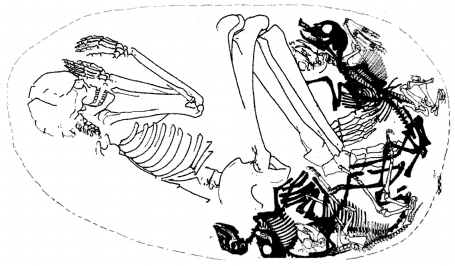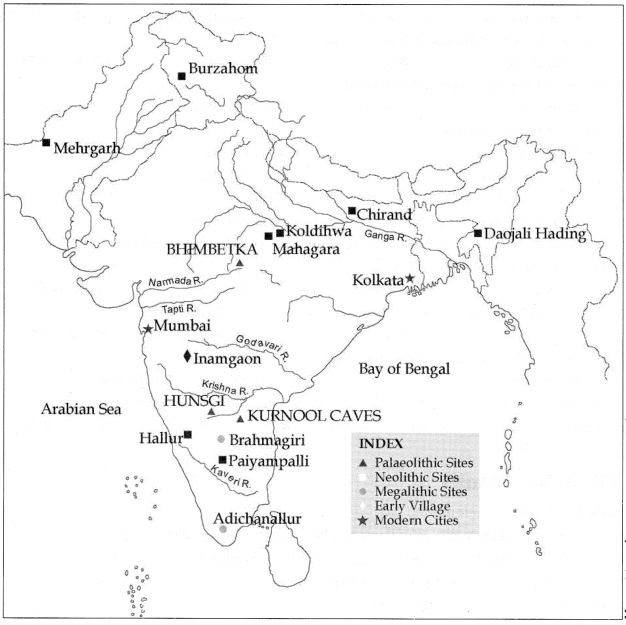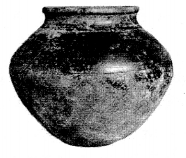From Gathering to Growing Food Class 6 History Chapter 3 Extra Questions and Answers Social Science CBSE Pdf free download are part of Extra Questions for Class 6 Social Science. Here we have given NCERT Extra Questions for Class 6 Social Science SST History Chapter 3 From Gathering to Growing Food.
You can also practice NCERT Solutions for Class 6 History Chapter 3 Questions and Answers on LearnInsta.com.
Class 6 History Chapter 3 Extra Questions and Answers From Gathering to Growing Food
From Gathering to Growing Food Class 6 Extra Questions and Answer History Chapter 3 Very Short Answers Type
Question 1.
What did Neinuo like to eat?
Answer:
She liked to eat boiled rice, squash, pumpkins, beans and meat.
Question 2.
Who has grown edibles in the garden plot?
Answer:
Her grandmother had grown vegetables.
Question 3.
Where did Neinuo go on school trip?
Answer:
She went to Madhya Pradesh.
Question 4.
How was food in Madhya Pradesh?
Answer:
In Madhya Pradesh the food was hot and spicy.
Question 5.
What are the main sources of food today?
Answer:
Plants and animals are the main sources of food today.
Question 6.
Where are different type of plants and animals found?
Answer:
In different climates, different types of plants and animals are found.
Question 7.
Where can sheep and goat survive easily?
Answer:
These can survive in dry and hilly environments.
Question 8.
Why the people start to protect the plants?
Answer:
The people started protecting the plants because they could grow and the seeds could ripen.
Question 9.
How do the people attract the animals?
Answer:
The people attract the animals by leaving food for them near their shelters.
Question 10.
What was the name of the first tamed animal?
Answer:
This was a wild ancestor dog.
Question 11.
Give the name of animals who come near to the people.
Answer:
Goat, sheep and pig also.
Question 12.
When did domestication start?
Answer:
About 12,000 years ago.
Question 13.
In the development of the civilization, how domestication play an important role?
Answer:
Most of the plants and animals we use today as food are the result of domestication.
Question 14.
Give the name of earliest domesticated plants.
Answer:
Wheat and Barley were probably the earliest domesticated plants.
Question 15.
Give the name of animals which were domesticated the earliest.
Answer:
The earliest domesticated animals were sheep and goat.
Question 16.
Did the people know the ways of storing the grains?
Answer:
Yes, they knew ways of storing the grains. They learnt the art of making clay pots. These clay pots were used for storing the grains and seeds.
Question 17.
Where did we find the remains of clay pots?
Answer:
Remains of clay pots were found in ‘Mehrgarh’ presently in Pakistan.
Question 18.
How did they use animals?
Answer:
Animals were used for multipurpose. They drank animal’s milk, ate meat and skin was used for covering the body as clothing.
Question 19.
What do you understand by ‘Dug Pits’?
Answer:
‘Dug Pits’ were used as a shelter by the people. Dug Pits were made after digging the ground.
Question 20.
Apart from food, what are the other things that could have been obtained from animals?
Answer:
Animals also provided milk, skin for wearing, hard bones for the tamed dog apart from the meat.
Question 21.
Where did we find remains of green gram?
Answer:
Remains of green gram were found in Chirand (presently in Bihar).
Question 22.
Where did we find remains of black gram?
Answer:
Remains of black gram were found in Paiyampalli (presently in Andhra Pradesh).
Question 23.
Where did we find remains of buffalo and ox?
Answer:
These were found in Chirand (presently in Bihar).
Question 24.
What was found in Mehrgarh?
Answer:
In Mehrgarh, we found wheat, barley, sheep, goat and cattle.
Question 25.
Where is ‘Koldihwa’ situated in present time and remains of which items were found there?
Answer:
Koldihwa is prently situated in Uttar Pradesh. In Koldihwa, rice and fragmentary animal bones found.
Question 26.
Where is Mehrgarh situated in present time?
Answer:
‘Mehrgarh’ is presently situated in Pakistan.
Question 27.
Which type of houses were found in Burzahom?
Answer:
In Burzahom, Pit houses with steps were found.
Question 28.
What did the existence of cooking hearths refer to?
Answer:
It referred that the people used cooked food and they were aware about fire.
Question 29.
Where did we find square and rectangular houses?
Answer:
Square and rectangular houses were found in Mehrgarh.
Question 30.
What did people do when anyone died?
Answer:
The people buried the dead person alongwith sheep and goat.
Question 31.
Where was Daojali Hading situated?
Answer:
This site was situated on the hills near the Brahmaputra valley close to routes leading into China and Myanmar.
Question 32.
Which important tools/objects were found in Daojali Hading?
Answer:
Mortars, pestles, jadeite and pottery etc., were found in Daojali Hading.
Question 33.
Give the name of stone which is probably brought from China.
Answer:
That is jadeite which has been brought from China.
From Gathering to Growing Food Class 6 Extra Questions and Answer History Chapter 3 Short Answers Type
Question 1.
What do you understand by ‘Domestication’?
Answer:
‘Domestication’ is a process in which plants and animals have been domesticated. Plants are grown and animals are reared in a suitable way. The early people selected those plants and animals that were not prone to disease.
Amongst animals, those that were relatively gentle, were selected. Likewise, plants that were relatively productive were selected. As a result, gradually, domesticated plants and animals became different from wild animals and plants.
Question 2.
What is the use of animals today?
Answer:
There are many uses of animals today. Animals are the main source of food. Milk of many animals/cattle is used. Animals also provide us leather which has now become an industrial raw material.
Various items are made up from the skin of animals which are also used as leather items such as shoes, bags, ladies purses, watches strips, belts and many more are industrial products which we are using in daily life. Apart from this, animal’s bones and its parts are used for medical purpose.
Question 3.
Which evidences are found in the subcontinent which indicated existence of farmers and herders?
Answer:
Scientists have evidence of plants and animals’ bones. Scientists identified these grains and bones of animals which clearly indicated that people grew crops and reared group of animals.
From Gathering to Growing Food Class 6 Extra Questions and Answer History Chapter 3 Long Answers Type
Question 1.
Illustrate about earlier and later levels of earth, How is this study useful for archaeologists?
Answer:
As we know that over the years, the surface of the earth is rising, because people discard waste material, and generally stay and rebuild houses in the same place. After hundred of years, this will lead to the formation of a mound.
So, when this mound is dug up, what is found from the upper layers of the mound is generally from a later time. Similarly, what is found from the lower layers of the mound is older. Archaeologists often referred to the upper and lower layers as levels. This can be understood from the picture given below:

When digging of earth was started, evidences were found in different levels of the earth which are helpful in the matter of what things were there at one time, which items people used before and which the people used later. The first used items will also be developed later. Such a way, chain of human development is developed by the archaeologists.
Question 2.
Make a list of activities performed by Tribesmen, WA, children and both by men and women.
Answer:
On some grounds, archaeologists believed that work was done by tribesmen, women, children or women and men together. Tribes follow occupations such as hunting, gathering, farming, herding and fishing etc. Their works have been described as follows by the archaeologists:
| Category | Related Work |
| Women | Most of agricultural work such as preparing ground, sowing seeds and grains, looking after the growing plants and harvesting grain. Women also thresh, husk and grind the grain. |
| Children | Often look after plants, driving away animals and birds etc. |
| Men | Tribes men usually lead large herds of animals in search of pastures. Usually men were regarded as leader. They may be old and experienced or brave warriors or priests. |
| Women and men combined work | Cleaning of animals and milking, making pots, tools, huts and basket, combined work |
Question 3.
Where was evidence of early farmers and herder found? Give name of places with its present location. Can you find out places on Indian Map?
Answer:
Archaeologists have found evidence of early farmers and herders at many places all over the world. Relating to the farmers activities, remains of grains like wheat, barley, rice, lentil, millet, green and black gram have been found. And remains of animals found were sheep, goat, cattle, fragmentary animal bones, dog, goat, buffalo, ox pig etc. The places where evidence of farmers and herders were found are:
- Burzahom (Kashmir),
- Mahagara (Uttar Pradesh)
- Koldihwa (Uttar Pradesh)
- Chirand (Bihar)
- Mehrgarh (presently in Pakistan)
- Hallur (Andhra Pradesh)
- Paiyampalli (Andhra Pradesh).
For Map

Picture Based Questions Class 6 History Chapter 3 From Gathering to Growing Food
Look at the picture given below. Please state its use in earlier times and in present.

Answer:
In the picture, a baked jar has been shown. This was prepared skillfully by mud and baked. It was earlier used to store the grains and seeds. People also used it for cooking the food.
In present time, these vessels are also used in the villages. Although the use of mud—made pots is very limited but still used in the villages. Women of the villages use this type of pot for:
(a) Boiling the milk, cooking of rice and pulses.
(b) Storing the agricultural produces.
(c) Putting money and ornaments.
(d) Storing drinking water etc.
Thus, we can see that this jar is almost having same nature of use in both the period. Only difference is that in the modern time, new objects are being used even in the villages.